Derek Zhiyuan Cheng
Jay
ActionPiece: Contextually Tokenizing Action Sequences for Generative Recommendation
Feb 19, 2025Abstract:Generative recommendation (GR) is an emerging paradigm where user actions are tokenized into discrete token patterns and autoregressively generated as predictions. However, existing GR models tokenize each action independently, assigning the same fixed tokens to identical actions across all sequences without considering contextual relationships. This lack of context-awareness can lead to suboptimal performance, as the same action may hold different meanings depending on its surrounding context. To address this issue, we propose ActionPiece to explicitly incorporate context when tokenizing action sequences. In ActionPiece, each action is represented as a set of item features, which serve as the initial tokens. Given the action sequence corpora, we construct the vocabulary by merging feature patterns as new tokens, based on their co-occurrence frequency both within individual sets and across adjacent sets. Considering the unordered nature of feature sets, we further introduce set permutation regularization, which produces multiple segmentations of action sequences with the same semantics. Experiments on public datasets demonstrate that ActionPiece consistently outperforms existing action tokenization methods, improving NDCG@$10$ by $6.00\%$ to $12.82\%$.
How to Train Data-Efficient LLMs
Feb 15, 2024
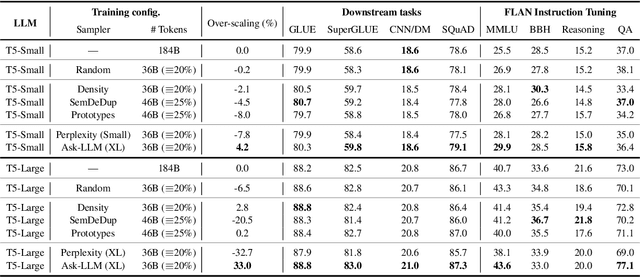
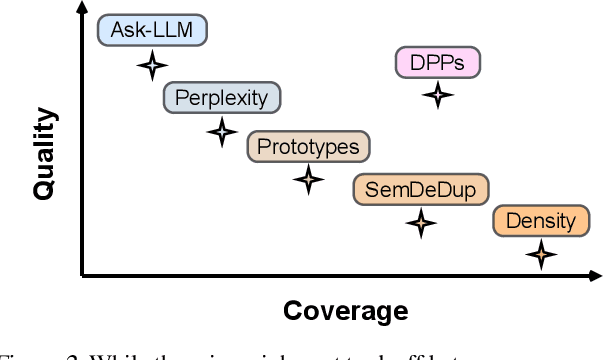
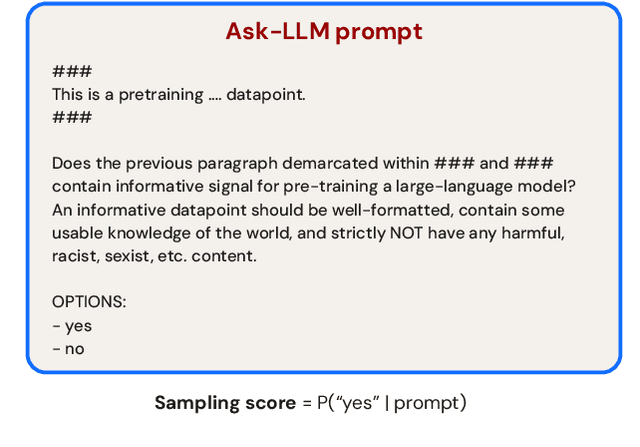
Abstract:The training of large language models (LLMs) is expensive. In this paper, we study data-efficient approaches for pre-training LLMs, i.e., techniques that aim to optimize the Pareto frontier of model quality and training resource/data consumption. We seek to understand the tradeoffs associated with data selection routines based on (i) expensive-to-compute data-quality estimates, and (ii) maximization of coverage and diversity-based measures in the feature space. Our first technique, Ask-LLM, leverages the zero-shot reasoning capabilities of instruction-tuned LLMs to directly assess the quality of a training example. To target coverage, we propose Density sampling, which models the data distribution to select a diverse sample. In our comparison of 19 samplers, involving hundreds of evaluation tasks and pre-training runs, we find that Ask-LLM and Density are the best methods in their respective categories. Coverage sampling can recover the performance of the full data, while models trained on Ask-LLM data consistently outperform full-data training -- even when we reject 90% of the original dataset, while converging up to 70% faster.
Farzi Data: Autoregressive Data Distillation
Oct 15, 2023



Abstract:We study data distillation for auto-regressive machine learning tasks, where the input and output have a strict left-to-right causal structure. More specifically, we propose Farzi, which summarizes an event sequence dataset into a small number of synthetic sequences -- Farzi Data -- which are optimized to maintain (if not improve) model performance compared to training on the full dataset. Under the hood, Farzi conducts memory-efficient data distillation by (i) deriving efficient reverse-mode differentiation of the Adam optimizer by leveraging Hessian-Vector Products; and (ii) factorizing the high-dimensional discrete event-space into a latent-space which provably promotes implicit regularization. Empirically, for sequential recommendation and language modeling tasks, we are able to achieve 98-120% of downstream full-data performance when training state-of-the-art models on Farzi Data of size as little as 0.1% of the original dataset. Notably, being able to train better models with significantly less data sheds light on the design of future large auto-regressive models, and opens up new opportunities to further scale up model and data sizes.
HyperFormer: Learning Expressive Sparse Feature Representations via Hypergraph Transformer
May 27, 2023Abstract:Learning expressive representations for high-dimensional yet sparse features has been a longstanding problem in information retrieval. Though recent deep learning methods can partially solve the problem, they often fail to handle the numerous sparse features, particularly those tail feature values with infrequent occurrences in the training data. Worse still, existing methods cannot explicitly leverage the correlations among different instances to help further improve the representation learning on sparse features since such relational prior knowledge is not provided. To address these challenges, in this paper, we tackle the problem of representation learning on feature-sparse data from a graph learning perspective. Specifically, we propose to model the sparse features of different instances using hypergraphs where each node represents a data instance and each hyperedge denotes a distinct feature value. By passing messages on the constructed hypergraphs based on our Hypergraph Transformer (HyperFormer), the learned feature representations capture not only the correlations among different instances but also the correlations among features. Our experiments demonstrate that the proposed approach can effectively improve feature representation learning on sparse features.
Unified Embedding: Battle-Tested Feature Representations for Web-Scale ML Systems
May 20, 2023Abstract:Learning high-quality feature embeddings efficiently and effectively is critical for the performance of web-scale machine learning systems. A typical model ingests hundreds of features with vocabularies on the order of millions to billions of tokens. The standard approach is to represent each feature value as a d-dimensional embedding, introducing hundreds of billions of parameters for extremely high-cardinality features. This bottleneck has led to substantial progress in alternative embedding algorithms. Many of these methods, however, make the assumption that each feature uses an independent embedding table. This work introduces a simple yet highly effective framework, Feature Multiplexing, where one single representation space is used across many different categorical features. Our theoretical and empirical analysis reveals that multiplexed embeddings can be decomposed into components from each constituent feature, allowing models to distinguish between features. We show that multiplexed representations lead to Pareto-optimal parameter-accuracy tradeoffs for three public benchmark datasets. Further, we propose a highly practical approach called Unified Embedding with three major benefits: simplified feature configuration, strong adaptation to dynamic data distributions, and compatibility with modern hardware. Unified embedding gives significant improvements in offline and online metrics compared to highly competitive baselines across five web-scale search, ads, and recommender systems, where it serves billions of users across the world in industry-leading products.
Do LLMs Understand User Preferences? Evaluating LLMs On User Rating Prediction
May 10, 2023Abstract:Large Language Models (LLMs) have demonstrated exceptional capabilities in generalizing to new tasks in a zero-shot or few-shot manner. However, the extent to which LLMs can comprehend user preferences based on their previous behavior remains an emerging and still unclear research question. Traditionally, Collaborative Filtering (CF) has been the most effective method for these tasks, predominantly relying on the extensive volume of rating data. In contrast, LLMs typically demand considerably less data while maintaining an exhaustive world knowledge about each item, such as movies or products. In this paper, we conduct a thorough examination of both CF and LLMs within the classic task of user rating prediction, which involves predicting a user's rating for a candidate item based on their past ratings. We investigate various LLMs in different sizes, ranging from 250M to 540B parameters and evaluate their performance in zero-shot, few-shot, and fine-tuning scenarios. We conduct comprehensive analysis to compare between LLMs and strong CF methods, and find that zero-shot LLMs lag behind traditional recommender models that have the access to user interaction data, indicating the importance of user interaction data. However, through fine-tuning, LLMs achieve comparable or even better performance with only a small fraction of the training data, demonstrating their potential through data efficiency.
Empowering Long-tail Item Recommendation through Cross Decoupling Network (CDN)
Oct 25, 2022Abstract:Recommenders provide personalized content recommendations to users. They often suffer from highly skewed long-tail item distributions, with a small fraction of the items receiving most of the user feedback. This hurts model quality especially for the slices without much supervision. Existing work in both academia and industry mainly focuses on re-balancing strategies (e.g., up-sampling and up-weighting), leveraging content features, and transfer learning. However, there still lacks of a deeper understanding of how the long-tail distribution influences the recommendation performance. In this work, we theoretically demonstrate that the prediction of user preference is biased under the long-tail distributions. This bias comes from the discrepancy of both the prior and conditional probabilities between training data and test data. Most existing methods mainly attempt to reduce the bias from the prior perspective, which ignores the discrepancy in the conditional probability. This leads to a severe forgetting issue and results in suboptimal performance. To address the problem, we design a novel Cross Decoupling Network (CDN) to reduce the differences in both prior and conditional probabilities. Specifically, CDN (i) decouples the learning process of memorization and generalization on the item side through a mixture-of-expert structure; (ii) decouples the user samples from different distributions through a regularized bilateral branch network. Finally, a novel adapter is introduced to aggregate the decoupled vectors, and softly shift the training attention to tail items. Extensive experimental results show that CDN significantly outperforms state-of-the-art approaches on popular benchmark datasets, leading to an improvement in HR@50 (hit ratio) of 8.7\% for overall recommendation and 12.4\% for tail items.
Deep Hash Embedding for Large-Vocab Categorical Feature Representations
Oct 21, 2020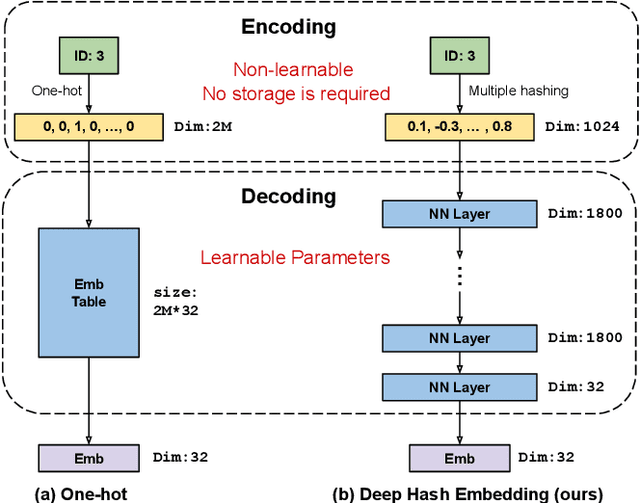
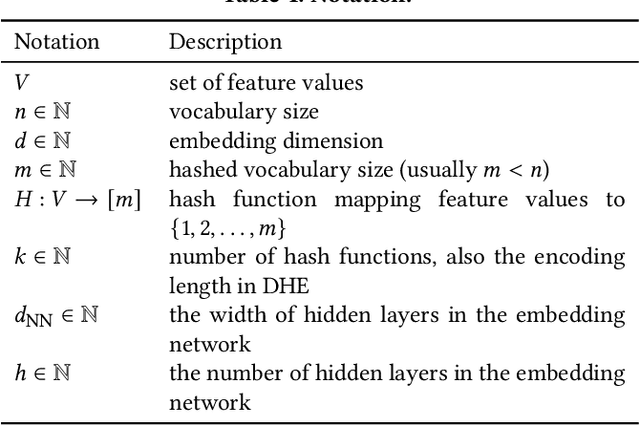
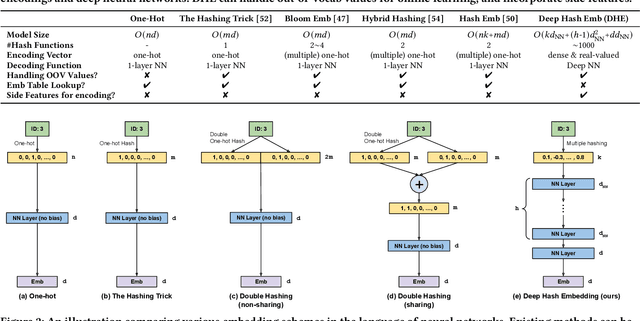
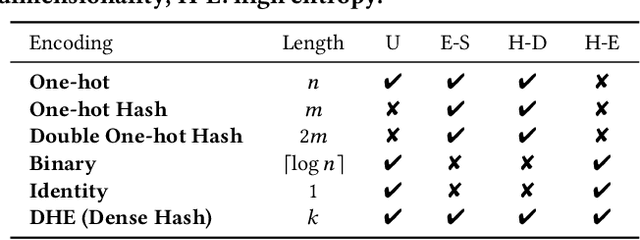
Abstract:Embedding learning for large-vocabulary categorical features (e.g. user/item IDs, and words) is crucial for deep learning, and especially neural models for recommendation systems and natural language understanding tasks. Typically, the model creates a huge embedding table that each row represents a dedicated embedding vector for every feature value. In practice, to handle new (i.e., out-of-vocab) feature values and reduce the storage cost, the hashing trick is often adopted, that randomly maps feature values to a smaller number of hashing buckets. Essentially, thess embedding methods can be viewed as 1-layer wide neural networks with one-hot encodings. In this paper, we propose an alternative embedding framework Deep Hash Embedding (DHE), with non-one-hot encodings and a deep neural network (embedding network) to compute embeddings on the fly without having to store them. DHE first encodes the feature value to a dense vector with multiple hashing functions and then applies a DNN to generate the embedding. DHE is collision-free as the dense hashing encodings are unique identifiers for both in-vocab and out-of-vocab feature values. The encoding module is deterministic, non-learnable, and free of storage, while the embedding network is updated during the training time to memorize embedding information. Empirical results show that DHE outperforms state-of-the-art hashing-based embedding learning algorithms, and achieves comparable AUC against the standard one-hot encoding, with significantly smaller model sizes. Our work sheds light on design of DNN-based alternative embedding schemes for categorical features without using embedding table lookup.
Beyond Point Estimate: Inferring Ensemble Prediction Variation from Neuron Activation Strength in Recommender Systems
Aug 17, 2020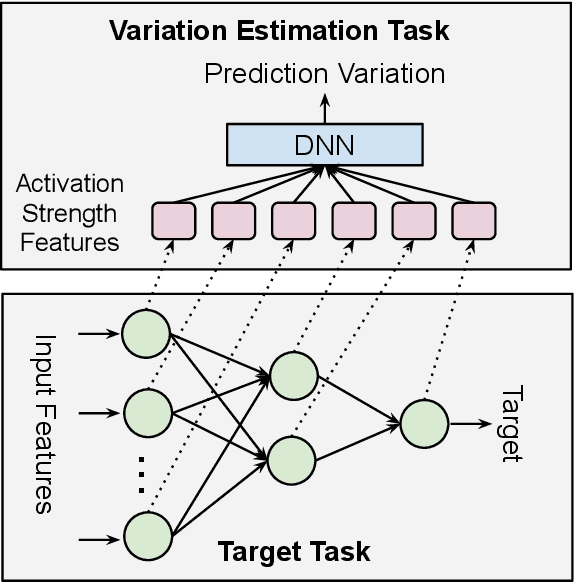


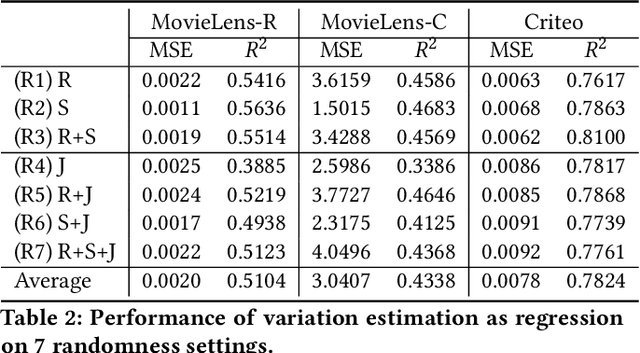
Abstract:Despite deep neural network (DNN)'s impressive prediction performance in various domains, it is well known now that a set of DNN models trained with the same model specification and the same data can produce very different prediction results. Ensemble method is one state-of-the-art benchmark for prediction uncertainty estimation. However, ensembles are expensive to train and serve for web-scale traffic. In this paper, we seek to advance the understanding of prediction variation estimated by the ensemble method. Through empirical experiments on two widely used benchmark datasets MovieLens and Criteo in recommender systems, we observe that prediction variations come from various randomness sources, including training data shuffling, and parameter random initialization. By introducing more randomness into model training, we notice that ensemble's mean predictions tend to be more accurate while the prediction variations tend to be higher. Moreover, we propose to infer prediction variation from neuron activation strength and demonstrate the strong prediction power from activation strength features. Our experiment results show that the average R squared on MovieLens is as high as 0.56 and on Criteo is 0.81. Our method performs especially well when detecting the lowest and highest variation buckets, with 0.92 AUC and 0.89 AUC respectively. Our approach provides a simple way for prediction variation estimation, which opens up new opportunities for future work in many interesting areas (e.g.,model-based reinforcement learning) without relying on serving expensive ensemble models.
Self-supervised Learning for Deep Models in Recommendations
Jul 25, 2020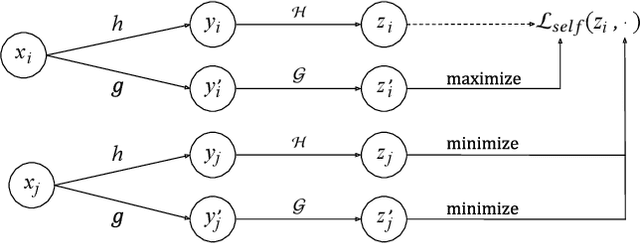
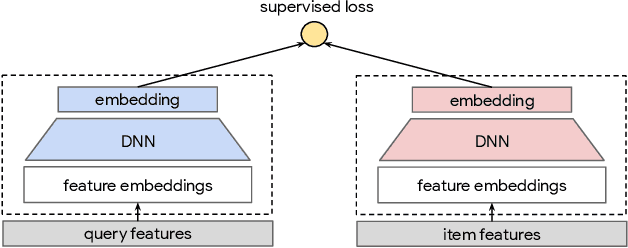
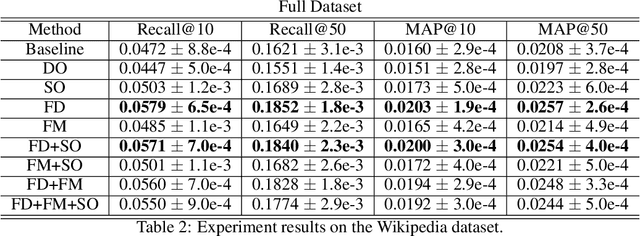

Abstract:Large scale neural recommender models play a critical role in modern search and recommendation systems. To model large-vocab sparse categorical features, typical recommender models learn a joint embedding space for both queries and items. With millions to billions of items to choose from, the quality of learned embedding representations is crucial to provide high quality recommendations to users with various interests. Inspired by the recent success in self-supervised representation learning research in both computer vision and natural language understanding, we propose a multi-task self-supervised learning (SSL) framework for sparse neural models in recommendations. Furthermore, we propose two highly generalizable self-supervised learning tasks: (i) Feature Masking (FM) and (ii) Feature Dropout (FD) within the proposed SSL framework. We evaluate our framework using two large-scale datasets with ~500M and 1B training examples respectively. Our results demonstrate that the proposed framework outperforms baseline models and state-of-the-art spread-out regularization techniques in the context of retrieval. The SSL framework shows larger improvement with less supervision compared to the counterparts.
 Add to Chrome
Add to Chrome Add to Firefox
Add to Firefox Add to Edge
Add to Edge